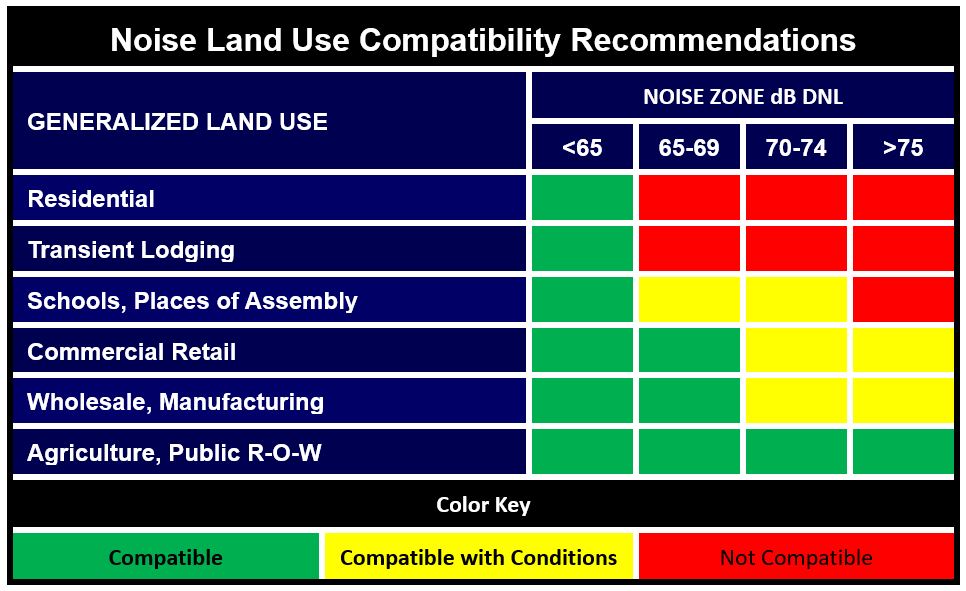Air Installations Compatible Use Zones, or AICUZ, is a program concerning people, safety and protection. The Department of Defense established the AICUZ program to promote proactive, collaborative planning for compatible development to sustain mission and community goals. This AICUZ study provides an analysis of the operational noise footprint, aircraft accident potential zones, or APZs, hazards to aircraft flight and land use development.
Planning Contours and the Day-Night Average Sound Level (DNL)
 Under the AICUZ program, the DOD models the anticipated operational tempo to provide noise contours to assist local communities in planning several years into the future. These planning contours provide stability to communities to allow for long term planning within the operational noise footprint.
Under the AICUZ program, the DOD models the anticipated operational tempo to provide noise contours to assist local communities in planning several years into the future. These planning contours provide stability to communities to allow for long term planning within the operational noise footprint.
Noise exposure is measured using the Day-Night Average Sound Level DNL. The DNL metric is based on the number of annual average daily aircraft operations over a 24-hour period. The DNL includes a 10 decibel (dB) adjustment, or penalty, for aircraft noise occurring between 10 p.m. and 7 a.m. because people are more sensitive to noise during that period. DNL has become the standard metric used by many government agencies and organizations, including the U.S. Environmental Protection Agency and the Federal Aviation Administration for addressing aircraft noise.
While noise attenuation is recommended for noise sensitive land uses within the noise footprint – measures to achieve noise reduction do not necessarily solve noise difficulties outside the structure. Therefore, the DOD does not recommend placing residential units within the 65 dB or greater noise footprint.
Accident Potential Zones
While the chances of an accident are remote, mishaps do occur and proper land use planning can reduce risk to persons on the ground. APZs are where an aircraft accident is likely to occur, if one occurs. However, they do not reflect the probability of an accident. APZs extend 15,000 feet from the end of each runway along the runway’s extended centerline. It should be noted that flight tracks are not roadways in the sky. Weather conditions, wind, pilot technique and other air traffic will cause some lateral deviation within the landing pattern around an airport.

Hazards to Aircraft Flight Zone
Certain land uses and activities can pose potential hazards to flight. To ensure land uses and activities are examined for compatibility, the Air Force has identified a Hazards to Aircraft Flight Zone. The HAFZ is defined as the area within the “Imaginary Surfaces” that are described in the UFC 3-260-01, and in 14 CFR Part 77.17. Unlike Noise and Safety Zones, the HAFZ does not have recommended land use compatibility tables. Instead, it is a consultation zone for the purposes of project applicants and local planning bodies to consult with the Air Force to ensure the project is built compatibly. These land uses and activities include:
• Uses that would attract birds, especially waterfowl
• Towers, structures, and vegetation that penetrate navigable airspace or are to be constructed near the airfield
• Lighting (direct or reflected) that would impair pilot vision
• Uses that would generate smoke, steam, or dust
• Electromagnetic interference (EMI) with aircraft communication, navigation, or other electrical systems.

Land Use Compatibility
In general, the DOD land use compatibility guidelines recommend that noise-sensitive land uses be placed outside high-noise zones and people-intensive uses placed outside of the APZs. Certain land uses are considered incompatible with APZs and high-noise zones, while other land uses may be considered compatible with restrictions (limits to density or size). The DOD encourages compatible development within communities – compatible uses can be found within the DOD land use compatibility tables. These land use recommendations are advisory in nature and are designed to support compatible growth. Recommendations found within AICUZ studies are nonbinding, local communities have ultimate responsibility for land use development within their jurisdiction.
Noise Land Use Compatibility Recommendations

Source: Adapted from AFI 32-7063. Refer to AICUZ Study Appendix A for details